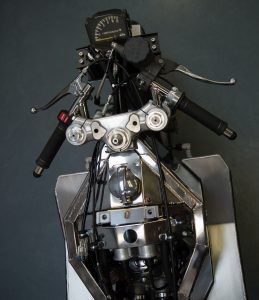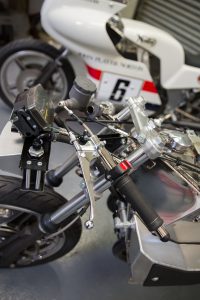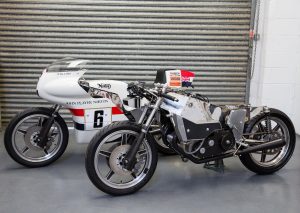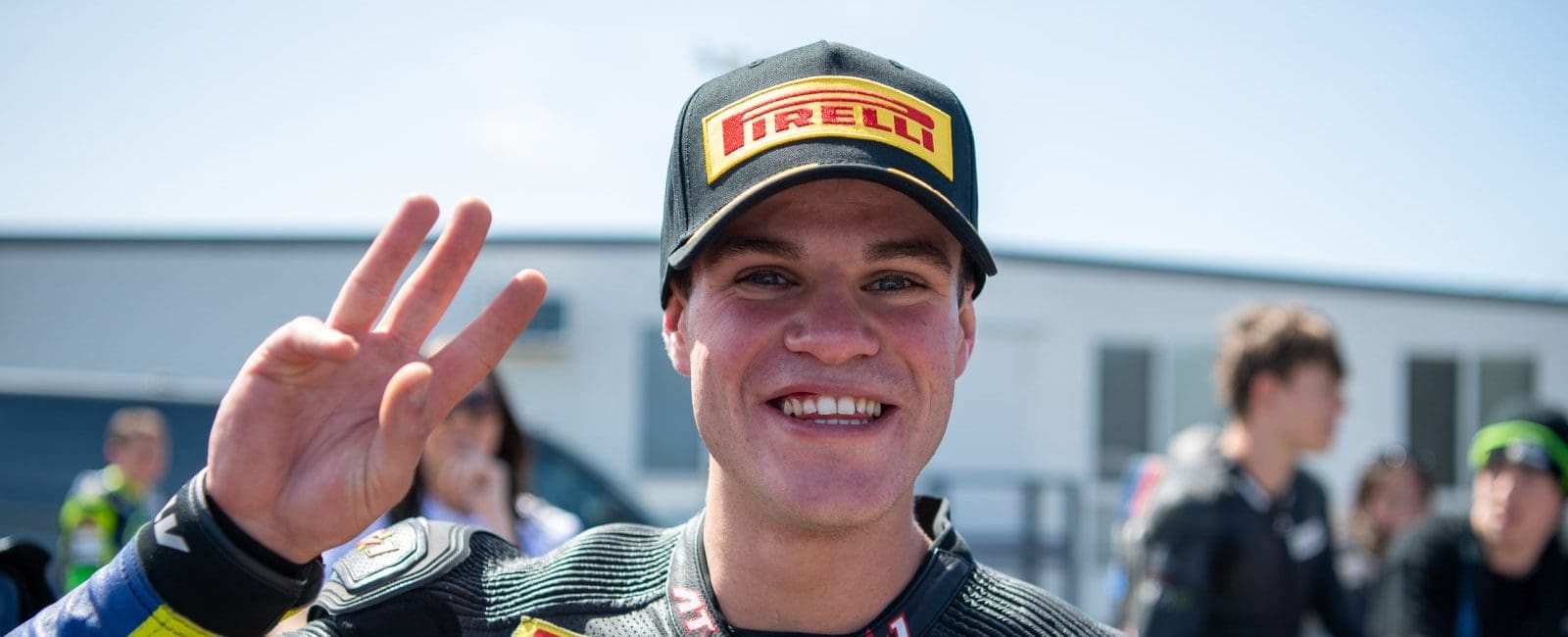Not many men have turned down the chance to race for the works Suzuki GP team, forfeited a ride with the Honda factory squad, and declined an offer to work as a designer for Yamaha. But for reasons of either patriotism or loyalty, Peter Williams did all of those things. Except for a brief link with MZ – with whom he scored the DDR/East German factory’s final GP race victory in 1971 – he raced exclusively aboard British bikes during his 10-year career. That ended in 1974 with his huge Oulton Park accident when the one-piece seat/tank unit came loose on the spaceframe version of the F750 John Player Norton, causing severe injuries that have sadly prevented him from riding a motorcycle again.
Now, 40 years on, after stints at Cosworth and Lotus and in between working as a consultant for major automotive industry players, Peter Williams, 70, is back in the bike world – and he’s delving into the past in order to move into the future.
“I like to do new things,” he says, “and that means I’m never satisfied with how motorcycles are right now. I’m focused more on envisaging how they might be.”
For Peter, the way of the future is the monocoque chassis. Right from the time he was at college, he has wanted to make a monocoque motorcycle.
Back then Colin Chapman had designed the monocoque Formula 1 Lotus, and Peter thought that concept would be perfect for a bike. He did indeed build the Norton monocoque in 1973, and raced that successfully, but for various reasons, it was not persevered with. Then he had his accident, Norton folded, and it all came to an end – but not for Peter.
Indeed, he has sought to develop a monocoque-framed streetbike for the past 40 years, and now he’s decided to try to finally raise the capital to do so by building 25 replicas of his TT-winning JPN monocoque for sale priced at GBP74,000 (A$150,000) plus tax, as part of a long-term plan aimed at bringing his ideas to fruition.
In 2012 he teamed up to form PWM/Peter Williams Motorcycles in partnership with Greg Taylor, owner of GTME Ltd, a specialist supplier of automotive and motorcycle engineering design services. They fabricate the monocoque frames themselves from modern stainless steel, integrating improvements to the design, such as separating the fuel and oil tanks from the chassis.

“It’s all too easy to damage the chassis with integral tanks,” Peter says. “My TT-winning bike which lives in Spain has a crease in the chassis from where I crashed it in the Imola 200 the month before the TT. So we’ve now got two separate fuel tanks either side outboard of the chassis, which have a reduced 15 litres total capacity compared to the original’s 24 litres – but that’ll be sufficient for the shorter classic races nowadays.”
Those of a literalist mindset may choose to argue that this therefore disqualifies the chassis from being termed a monocoque, if the fuel is carried separately from the frame!
The replica racer carries the same brakes as the original motorcycle – a pair of 254mm cast iron discs up front, and a single 215 mm rear, all three gripped by the benchmark twin-piston Lockheed calipers of the era. The complete weight of the Replica is 145kg dry, split 48/52 per cent rearwards, exactly the same as the original bike.
The replicas are powered by a brand-new version of the same long-stroke 746cc Norton Commando engine as the original monocoque. The five-speed gearbox was originally the Achilles heel of the tuned Formula 750 Norton twins, but the modification which resolved this is included in the latest-spec Hemmings gearbox fitted to the JPN monocoque replicas. According to Peter, “it’s a very sweet gearbox to use, now”.
The chance to find that out for myself – and to become the only person fortunate enough to have ridden both a PJW monocoque replica and the bike it’s copied from – came on a late autumn day at Donington Park. Fortunately, Donington’s higher noise limit accommodated the gloriously distinctive offbeat drone emanating from the Norton’s period twin open meggas. Remember, exhaust silencers only arrived in 1976 for bike racing. Hearing the engine light up immediately stamps it as a British parallel-twin with a 360º two-up crankshaft. Nothing else in the global panoply of motorcycling sounds like this.
Equally unique is Peter Williams’ trademark riding position, one of the most unusual in modern-day motorcycling, which I’d already sampled by riding his JPN TT-winner. The PWM replica recaptures this completely.
The Norton is very low and slim – it’s improbably tiny for a 750 – but relatively long, so you must squeeze into a snug, low, semi-forward stance that has the seat quite far back and your arms reaching forward to the short, stubby handlebars. These position your hands very close together, next to the steering head, and are partially obscured from view by the all-enveloping fairing. Don’t think about waving to the fans until after you’ve won the race, because you’d never get your hands back inside the fairing if you did. Unless of course you’re Peter Williams, who had a lot of practice!

Pushstarts on your own are an absolute no-no, though, probably even for him. You need to feed your body into the streamlining till you’re sitting aboard the bike with someone to push you, though it does fire up very easily when you drop the clutch. Really, the riding position reminds me most of a modern-day track bicycle, with hands close together for maximum wind-cheating effect. But compared to the original TT-winner, the replica has a slightly more spacious stance, so I was actually able to get my helmet down behind the screen along the Donington straight, which was quite impossible on the original bike.
A mark of Peter Williams’ distinctive riding style was the way he took wide, sweeping lines in turns rather than squaring them off. This technique was honed by years of racing underpowered GP singles against Italian multis, where the vital thing was to keep up momentum and maintain corner speed. Like its forebear, the monocoque replica steers beautifully in big, sweeping corners like Craner Curves at Donington, invariably holding exactly the line you set it thanks to its relatively long 1420mm wheelbase and kicked-out 27º head angle.
On the flipside, there is some power understeer in slower corners. When you get hard on the throttle exiting a turn, it doesn’t always want to hold a tight line, and pulling it back on line makes you glad that the light, precise steering allows you to counter this quite readily. It could also be that I needed to have a couple more clicks of preload on the rear Ikon shocks. But turn-in is good. The Norton goes exactly where you point it entering a bend, even if the all-enveloping bodywork does feel slightly awkward – it takes some getting used to.
Within the limitations of the twin-shock rear end, the JPN replica copes well with any bumps you meet cranked over on the angle. The fork is pretty responsive, but by modern standards the twin Ikon shocks don’t have much travel. That’s not so much a problem on a smooth short circuit like Donington, but I know from riding the shorter-wheelbase ’74 JPN spaceframe bike in the Isle of Man that its twin-shock package gave a very lively ride over bumps. The longer wheelbase on the monocoque would help smooth this out.
By the standards of 40 years ago, the JPN monocoque must have been a great bike for the TT or a big, fast circuit like Silverstone, relying on the low cee of gee to make it both stable over bumps and reasonably quick-steering. You could park yourself aboard the seat rather than hanging off the bike to help it steer, as was not yet the fashion in those pre-kneeslider days.

No big surprise with a Hemmings engine, but the replica was beautifully punchy and vibration-free, running with turbine-like smoothness while remarkably eager to rev. I’ve ridden many Norton twins down the years, both road and race, and the only engines which equal Mick’s for smoothness are the JPN engines that P&M’s Richard Peckett built up for the Folch bikes. It’s a pleasure to hold the throttle wide open in top gear with the engine booming away beneath you, yet no sign of the vibromassage always inflicted on me by other twin-cylinder Britbike racers.
The monocoque’s Isolastic engine mountings surely play a key role in this, to the point where it’s hard to credit that this pushrod twin has no power-sapping balance shafts, and on the contrary has two big pistons rising and falling together. The turbine-like power delivery starts in earnest at 4000rpm, once the twin megaphone exhausts stop hiccuping and the engine cleans out, then builds strongly to peak power at 7400rpm, with another 200 revs available safely beyond that.
“I never revved the bike higher than 7600rpm or much lower than 5000,” says Peter Williams, and after sampling his replica, I understand why. The engine picks up revs very fast, with less inertia than most other big twins of the era I’ve ridden, and suddenly it’s time to change up on the right-foot gear lever. The five-speed Hemmings gearbox has well-chosen ratios and the shift action is, as promised, sweet and precise with down for first gear, then up for the four higher ratios, but it’s definitely rather slow, meaning you must use the clutch even for upward shifts. In best MV Agusta/Monza style, there’s just 500rpm between fourth and top gear – ideal for Silverstone, too – with around twice that between the other ratios.
Changing up at just over 7000rpm as I did gives impressive acceleration for what at 145kg dry is quite a heavy bike. It may ‘only’ be a humble air-cooled pushrod twin, but once wound up the JPN replica motored past modern 600 fours down the Donington straight, thanks to the masses of strong, usable midrange power on tap. Nice!
I’d experienced the same mighty midrange on the original JPN TT-winner when I rode it at Snetterton and Mallory Park open practice days. But the 600 Superstocks I found myself running with there would get me back every time on the brakes. Even by the standards of 40 years ago, the Folch-owned JPN’s 10-inch Norvil discs were a disappointment. On the PJW Replica with exactly the same brake package, that’s but a memory – the way the new bike brakes bears no resemblance to the old one. I was really impressed with how well it stopped, even though I didn’t use significant engine braking for fear of chattering the rear wheel on the overrun. There’s lots of feedback from the front discs via the brake lever, so no risk at my calmer pace of locking the front wheel as Peter Williams says he occasionally did in the heat of action! Compared to the stainless steel discs on Japanese bikes back in the 70s, these would have been lightyears better in terms of effectiveness and feel.

In every way, the JPN monocoque replica is a credit not only to Peter Williams, the man who conceived and rode the original first time around, but also the GTME team that has constructed such a faithfully close copy of it today. In doing so they’ve re-created what is a significant milestone in the evolution of two-wheeled chassis design.
As a long-time admirer of the JPN monocoque, and with the added privilege of now having ridden one on three occasions, I’m left with a sense of satisfaction, as well as anticipation. I remember my feelings of frustration after the first time I rode Joaquin Folch’s original TT-winner, of which the replica is such a faithful copy, but with the added benefit of brakes that work! For if ever a chassis cried out for a more powerful, more sophisticated, more modern engine than the archaic anachronism the Norton air-cooled twin represented – even in 1973 against its Japanese rivals – it was this one.
Well, now Peter Williams and Greg Taylor have combined their talents to do precisely that. The bike that did the most with the least 40 years ago has been lovingly re-created and improved, and is now available for (admittedly well-heeled) customers to experience in replica guise.
If all goes according to plan, this will be the first stage of a much larger project. Peter and Greg’s shared vision is of a modern-style monocoque powered by the benchmark hypersports motor of the modern era, the Honda CBR1000RR Fireblade. You don’t have to be a PJW or a Norton fan to hope this becomes a reality.

TEST ALAN CATHCART
PHOTOGRAPHY CHRIS DE VINE & KYOICHI NAKAMURA











